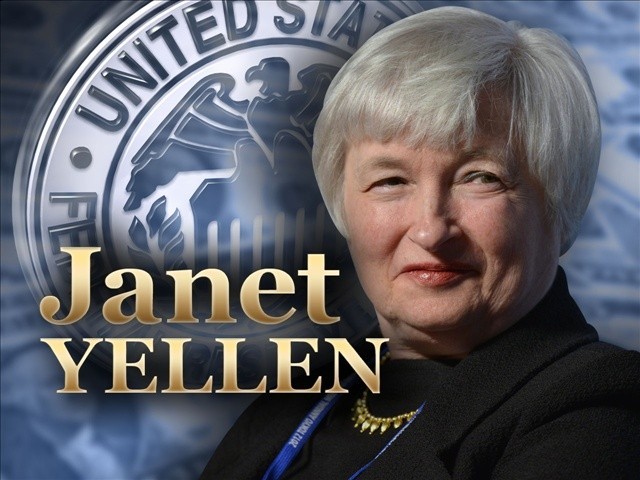At the same time, the Fed at least opened the door to a rate increase later this year by no longer saying it will be "patient" in starting to raise its benchmark rate.
The statement the Fed issued after its latest policy meeting appeared to catch investors by surprise in suggesting that a rate increase might be further off than many had assumed. Stock prices surged and bond yields fell. The Dow Jones industrial average, which had been down nearly 100 points before the statement was issued, was up more than 220 points an hour later - and ended the day up 227. (See link below.)
The Fed has kept its key short-term rate near zero since late 2008 to bolster the economy after a devastating financial crisis and recession. In its statement, the Fed noted that the economy, which it previously said was growing solidly, has "moderated somewhat."
Dan Greenhaus, chief strategist at BTIG, said the Fed's statement Wednesday lowered the odds of mid-year rate hike.
"What's important about this part of the statement is that it clearly says the FOMC is looking for `further' improvement, meaning the economy and labor market have not yet met whatever criteria necessary to warrant a rate hike," Greenhaus said in a note to clients.
Patrick Maldari, a senior fixed-income specialist at Aberdeen Asset Management, agreed that the Fed appears in no hurry to raise short-term rates.
"They went out of their way to talk about weakness in export growth, weakness in energy prices," Maldari said.
At a news conference after the Fed's statement was released, Chair Janet Yellen suggested that the broad pay increases that are normally associated with steady job growth may not occur anytime soon.
Yellen said the Fed would not necessarily wait for wages to rise at a faster pace before it raises its key rate from its current near-zero level.
"We may not see wage growth pick up," she told reporters.
Since December, the Fed had said it could be "patient" in beginning to raise its benchmark rate from near zero. Most analysts said that dropping "patient" from its statement would signal that the Fed was moving toward a rate increase, perhaps as soon as June. A rate hike would ripple through the economy and could slow borrowing and possibly squeeze stocks and bonds.
But other economists had said that even if the Fed dropped "patient," any rate increase would reflect the latest data and that the Fed would remain flexible. Key sectors of the economy have been less than robust of late, and inflation remains far below the Fed's target rate.
On Wednesday, the Fed's statement was approved on a 10-0 vote.
In its characterization of the economy, the statement said export growth has weakened, a trend that partly reflects a stronger dollar that's made U.S. goods costlier overseas.
The statement said that before raising rates, Fed officials want to be "reasonably confident that inflation will move back to its 2 percent objective over the medium term."
On Wednesday, the Fed also downgraded its quarterly economic forecasts. It cut its estimate of growth this year to a range of 2.3 percent to 2.7 percent, from an estimate of 2.6 percent to 2.7 percent in its last forecast issued in December. It was an acknowledgement that some key indicators have been weaker than expected in recent months.
The Fed also forecast that the unemployment rate can now fall further without spurring inflation, a sign that it may move slowly in raising rates.
Officials reduced their estimate of the unemployment rate that they think is consistent with a healthy economy to a range of 5 percent to 5.2 percent. That's down from a previous range of 5.2 percent to 5.5 percent. Unemployment now stands at 5.5 percent, the top of the previous range.
Historically, the Fed raises rates as the economy strengthens in order to control growth and prevent inflation from overheating. Over the past 12 months, U.S. employers have added a solid 200,000-plus jobs every month. And unemployment has reached a seven-year low of 5.5 percent, the top of the range the Fed has said is consistent with a healthy economy.
The trouble is that the Fed isn't meeting its other major policy goal - achieving stable inflation, which it defines as annual price increases of around 2 percent. According to the Fed's preferred inflation gauge, prices rose just 0.2 percent over the past 12 months. In part, excessively low U.S. inflation reflects sinking energy prices and the dollar's rising value, which lowers the prices of goods imported to the United States.
U.S. manufacturers are struggling with falling exports, the housing recovery remains slow and consumers - the drivers of the economy - have seemed reluctant to spend their windfall savings from cheaper energy. What's more, pay for many workers remains stagnant, and there are 6.6 million part-timers who can't find full-time jobs - nearly 50 percent more than in 2007, before the recession began. Some analysts have downgraded their outlook for growth in the first three months of 2015.

http://accesswdun.com/article/2015/3/286481
